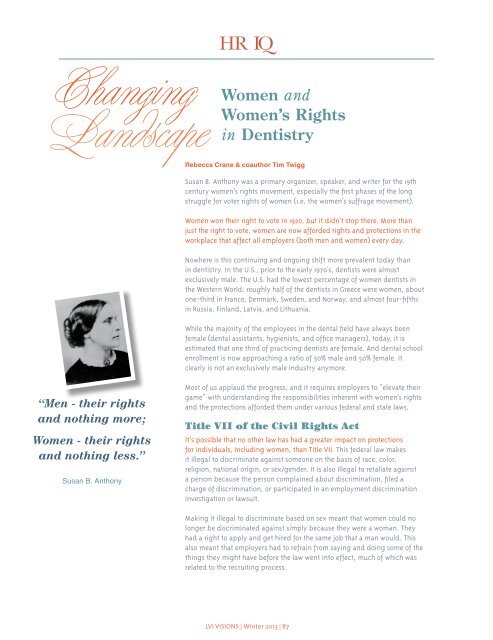Visions
Visions
Visions
You also want an ePaper? Increase the reach of your titles
YUMPU automatically turns print PDFs into web optimized ePapers that Google loves.
Changing<br />
Landscape<br />
“Men - their rights<br />
and nothing more;<br />
Women - their rights<br />
and nothing less.”<br />
Susan B. Anthony<br />
HR IQ<br />
Women and<br />
Women’s Rights<br />
in Dentistry<br />
Rebecca Crane & coauthor Tim Twigg<br />
Susan B. Anthony was a primary organizer, speaker, and writer for the 19th<br />
century women’s rights movement, especially the first phases of the long<br />
struggle for voter rights of women (i.e. the women’s suffrage movement).<br />
Women won their right to vote in 1920, but it didn’t stop there. More than<br />
just the right to vote, women are now afforded rights and protections in the<br />
workplace that affect all employers (both men and women) every day.<br />
Nowhere is this continuing and ongoing shift more prevalent today than<br />
in dentistry. In the U.S., prior to the early 1970’s, dentists were almost<br />
exclusively male. The U.S. had the lowest percentage of women dentists in<br />
the Western World: roughly half of the dentists in Greece were women, about<br />
one-third in France, Denmark, Sweden, and Norway, and almost four-fifths<br />
in Russia, Finland, Latvia, and Lithuania.<br />
While the majority of the employees in the dental field have always been<br />
female (dental assistants, hygienists, and office managers), today, it is<br />
estimated that one third of practicing dentists are female. And dental school<br />
enrollment is now approaching a ratio of 50% male and 50% female. It<br />
clearly is not an exclusively male industry anymore.<br />
Most of us applaud the progress, and it requires employers to “elevate their<br />
game” with understanding the responsibilities inherent with women’s rights<br />
and the protections afforded them under various federal and state laws.<br />
Title VII of the Civil Rights Act<br />
It’s possible that no other law has had a greater impact on protections<br />
for individuals, including women, than Title VII. This federal law makes<br />
it illegal to discriminate against someone on the basis of race, color,<br />
religion, national origin, or sex/gender. It is also illegal to retaliate against<br />
a person because the person complained about discrimination, filed a<br />
charge of discrimination, or participated in an employment discrimination<br />
investigation or lawsuit.<br />
Making it illegal to discriminate based on sex meant that women could no<br />
longer be discriminated against simply because they were a woman. They<br />
had a right to apply and get hired for the same job that a man would. This<br />
also meant that employers had to refrain from saying and doing some of the<br />
things they might have before the law went into effect, much of which was<br />
related to the recruiting process.<br />
LVI VISIONS | Winter 2013 | 87


